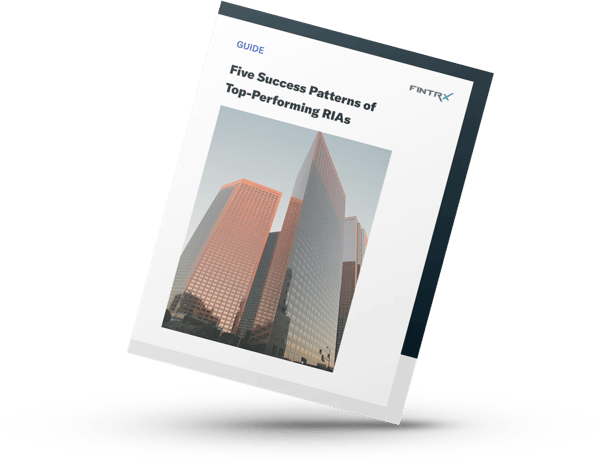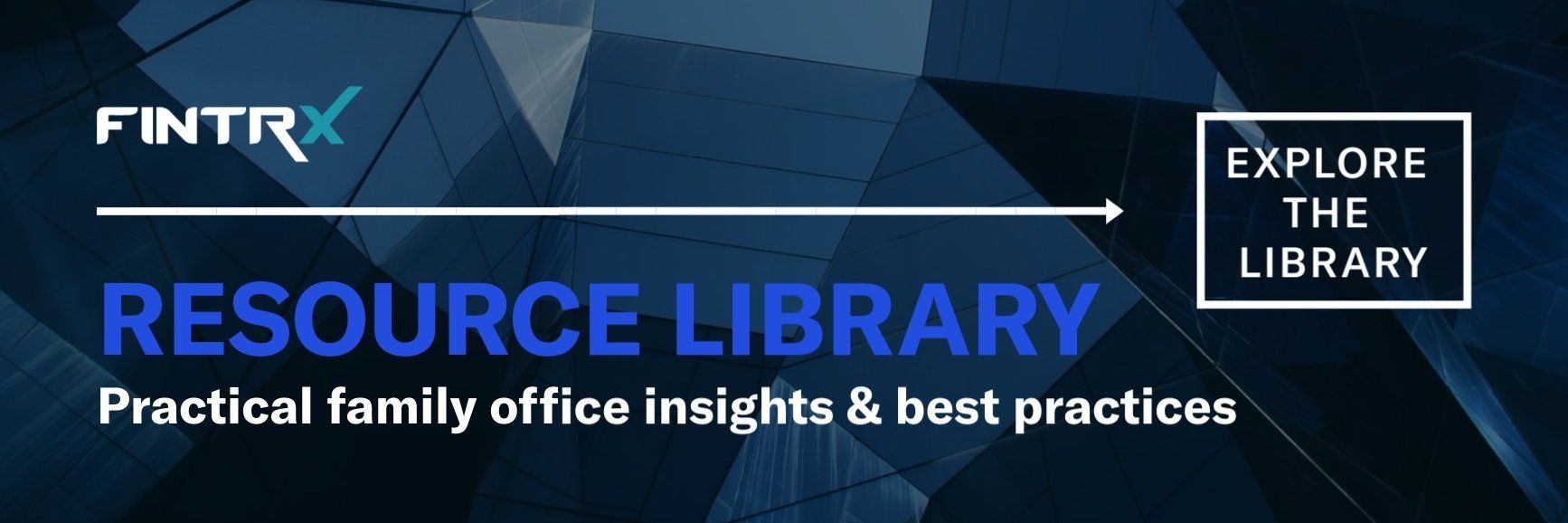START YOUR FREE TRIAL
GET STARTED
The Industry’s Most Trusted Private Wealth Data—Comprehensive, Accurate, and Current
Explore the leading platform used by asset managers to find and engage with RIAs, Broker-Dealers, Family Offices, Foundations & Endowments. Request your free trial of FINTRX now and see for yourself.
Blog & Resources
NEWS AND INSIGHTS FROM FINTRX
5 Success Patterns of Top-Performing RIAs
Amidst a global pandemic, registered investment advisors (RIAs) are continuing to gain attraction as the need for truly unbiased asset management becomes increasingly popular among high net-worth individuals. By restructuring internal operations, RIAs throughout the United States are identifying and implementing alternative methods to best serve their clientele. As numbers continue to rise each year, our team has taken a deep dive into the registered investment advisor space - offering data and insight into how these groups operate, developing trends, and five success patterns of top-performing RIAs.
With trillions of dollars in assets under management, the RIA landscape as a whole is expanding and many groups are leveraging modern solutions to fit the specific wants and needs of each client.
Before diving into the deep end, we provide a brief overview of RIAs below:
A registered investment advisor (RIA) is often described as any firm advising or managing the wealth of ultra high net-worth individuals or institutions. Although many of these firms cater mainly to high net worth clients and institutional investors, some of them also deal with clients in the middle or upper-middle class. Directly regulated by the Securities Exchange Commission (SEC), RIAs offer a wide range of wealth management services to their client base. RIAs must fully understand the client's definition of financial success to best fulfill their fiduciary duties.
All RIAs are fiduciary organizations, and therefore:
- Have a legal obligation to act in their clients' best interest
- Must be registered with the SEC or their respective state's regulatory body
- 100M+ in assets (AUM) must be registered with the SEC (with few exceptions)
1. Craft a Solidified Service Model
Breadth of service is a key theme among RIAs this year, with many advisors offering retirement preparation, tax management, philanthropic planning and other aspects of clients’ financial lives beyond just investing. Successful RIAs carefully consider the services they plan to offer and whether the profile of those they’re targeting are in need and prepared to pay for those services.
For those interested in getting started, once you nail this down and have a confident understanding of your own go-to-market strategy, you will need to develop how to package your services and marry that to an ideal fee structure.
A broader and more holistic client experience can really differentiate a firm, but only if the firm clearly understands who it wants to serve, so it can create an optimal client experience. In the end, it is not about finding one particular strategy to make a difference, but instead building a strong foundation that is consistent with the client’s journey. Managing even a small RIA of a half dozen individuals now requires firm owners and/or management to effectively develop and communicate a compelling vision, foster a culture centered on execution of key objectives, build processes for identifying and solving key issues, and most importantly, implement a framework for managing the wealth and investments of affluent families worldwide.
2. Spend Money to Make Money
Too many advisors focus on net income, according to Scott Hanson, CEO of Allworth Financial, a $3.5 billion private equity-backed RIA based in Sacramento, California.
It is a challenge to find the right balance in most industries and wealth management is no exception. RIA growth requires spending money and time on the tools and technology needed to fuel business development. Focusing too much time on income from the start will inevitably lead to short-sighted practices, whereas investing in yourself and your business will unlock much greater value in the long term.
Nowadays, successful RIAs dedicate time to weekly business development. In order to remain successful and unique as a registered investment advisor, it is important to set aside time to restructure and strengthen internal processes. Oftentimes you will see these groups investing in the technologies needed to operate efficiently. As the RIA industry’s continued growth has catapulted more and more firms across the $100M AUM threshold and transformed many practices into true businesses, many firms have grown beyond themselves as the original founders and into professionally managed sustainable enterprises.
3. Move Up and Down the Market
Servicing high-net-worth clients requires a refined skill set while servicing those with lower net worths may not always be profitable. To find where you are best suited to bring your skills to the table, it is best to lean into your hobbies, i.e. what might be an interesting angle to lead with (golf, photography, travel) and personalize your outreach to prospective clients across a broad spectrum.
As more and more financial advisors deliver comprehensive financial planning and wealth management services to clients, it is becoming harder to differentiate from those offering similar services. Though as long as clients are well served, they tend to remain clients. The bad news, though, is that firms who are unable to differentiate will struggle to grow, even if they are serving their clients well and providing value (because the prospective client’s perception is that every other advisor does, too). The key to growth as a registered investment advisor is not just to be better, but to be different as well - crafting a unique value proposition that is relevant for the particular target market the you wish to serve. This requires identifying specific niche solutions to attract some or all of the target market.
Important to Note:
- - Market positioning involves knowing who your ideal client is, who the various buyer personas are and what they care most about, what problem(s) you solve and why your product/service is better than the alternatives
- - Articulate why you are different in a way that resonates with clients/prospects
4. Build a Strategy to Garner Referrals
-
Referrals are among the top ways sellers get leads and new business, but many struggle with generating them consistently. Ensuring that you are providing white glove service to your flagship clients is critical to how successful RIAs enable organic growth. Taking care of your current clients while crafting a trusted line of communication will put you in an optimal position to elicit referral business.
While business development and marketing are important strategies, the traditional route of building your business based on client referrals with a 'client first' mentality is vital to establish.
-
Important to Note:
- - The proven method for securing referrals is to provide an outstanding service experience first
- - Make building rapport with clients a top priority (creates trusting and mutually beneficial relationships)
- Remain genuinely interested in your clients as individuals, not solely a customer willing to buy your product or service (i.e. ask how their day is going or what their plans for an upcoming holiday are - this strengthens your connectivity almost immediately)
5. Consider Compliance
Dialing in a compliance program is an important step that top-performing RIAs prioritize. There are regulatory guidelines and requirements to keep in mind to ensure your business is always in compliance. Too many people think about risks in terms of outside forces that can affect an organization. What many fail to understand is that most threats and opportunities are generated internally. In the simplest terms, the Investment Advisers Act of 1940 (the “Advisers Act”) requires RIAs to establish policies and procedures that will help prevent violations of the law. The Securities and Exchange Commission (the “SEC”) establishes rules and provides interpretations and guidance that help RIAs understand the responsibilities set forth by the Advisers Act. Compliance ensures key regulatory objectives are met.
Consider adding a technology program specific to managing compliance to your tech stack to make sure you are on top of this part of your business.
Conclusion
In a time of unprecedented challenges, registered investment advisors are looking for unique opportunities in every direction. Using these five success patterns, RIAs throughout the United States continue to push ahead. Advisors must remain vigilant and committed to their operating business model if they are to succeed in the coming years. Getting started in becoming an RIA requires a dedication and drive in all of these areas. By focusing on internal operations and other business fundamentals, many RIA firms are advancing and evolving - even in turbulent markets.
To download the full version of this guide, access your copy below.

The utilization of our family office data and research platform has opened doors to the many investment trends that shape our global economy. Engineered to help our clients identify and access family office capital in an intuitive and efficient manner, the FINTRX family office platform offers accurate family office data and research, built with a bottom-up approach.
For an in-depth exploration of the FINTRX family office platform, click below:
For more practical family office insights and best practices, visit the FINTRX 'Resource Library' below.
Written by: Renae Hatcher |
December 04, 2020
Renae Hatcher is a member of the marketing team at FINTRX - focused on delivering targeted & relevant family office and registered investment advisor content to our subscribers.
Similar Content
COMPANY
COMPARE US

Copyright © 2025 FINTRX, Inc. All Rights Reserved. 18 Shipyard Drive Suite 2C Hingham, MA 02043 Data Privacy Policy
.png?width=367&height=109&name=ezgif.com-gif-maker%20(3).png)




